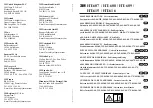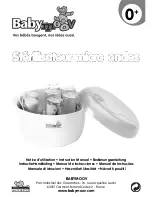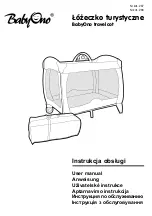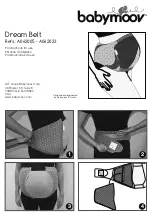
EWB100 Usage and Deployment Guide
Rev 1.13
Page 95
The search of the clip tables to build clip-id is done at two different times. The
first time is at startup when the device builds all the clip-id based on the Default
Dictionary. For each name in the Default Dictionary, the device will search the
available clip tables in order outlined above and build the clip-id. Hence any of
the Default Dictionary clips can be overlaid by either Flash or Ram tables.
The second time the search is done is when a data structure that uses an audio
clip is referenced for the first time. These are mostly likely clips specified during
the configuration process, such as the name of a profile or one of the audio alerts
associated with a profile.
19.4
Clip Names, User Notifications, and Configuration
On EWB100 devices, the audio clip associated with any given audio alert can be
changed using Clip names and/or downloadable Clip Tables.
Audio messages to the user fall into one of three categories:
Device wide
Per Profile
Directory Entries
Device wide audio messages use audio clips defined in the Default Dictionary.
They are mostly used for status and configuration messages. To change them
requires overlaying the clips defined in the Default Dictionary. These are targeted
mostly at support personal (ie. “IP address”) but some can be heard by regular
users as well (such as the volume up/down tone).
Changing the audio clip defined in the default dictionary can only be done by
placing the name of the audio clip in either a flash or ram clip table along with the
new audio clip. When the system starts up, as described previously, the system
will use the first clip name found in the clip table and build the clip-id referring to it
rather than the default table.
Per profile messages are most of the audio prompts that are visible to everyday
users. These include alerts that indicate the start or end of a voice session,
battery status, radio connectivity, etc. There are default values for all of these
prompts that use the entries in the Default Dictionary. The defaults can be
overridden by configuring the profile entry with new clip name. They can also be
changed by redefining the clip associated with the entry in the default dictionary.
Changing the default value in the profile is the easiest and can be done by the
command:
set pr alert xn z
Where x is the name of the alert (lowbat, outofrange, etc), n is the profile number
(0-7), and z is the new clip name. The clip name must be defined in some clip
table. Otherwise the silence clip is used by default.
Summary of Contents for TEAM Badge (EWB100)
Page 12: ...EWB100 Usage and Deployment Guide Rev 1 13 Page 12 ...
Page 37: ...EWB100 Usage and Deployment Guide Rev 1 13 Page 37 ...
Page 39: ...EWB100 Usage and Deployment Guide Rev 1 13 Page 39 ...
Page 49: ...EWB100 Usage and Deployment Guide Rev 1 13 Page 49 set pr rxwttmask 0 z where z 1 x 1 1 y 1 ...
Page 57: ...EWB100 Usage and Deployment Guide Rev 1 13 Page 57 ...
Page 134: ...EWB100 Usage and Deployment Guide Rev 1 13 Page 134 Wait while the driver installs Wait ...
Page 146: ...EWB100 Usage and Deployment Guide Rev 1 13 Page 146 ...
















































